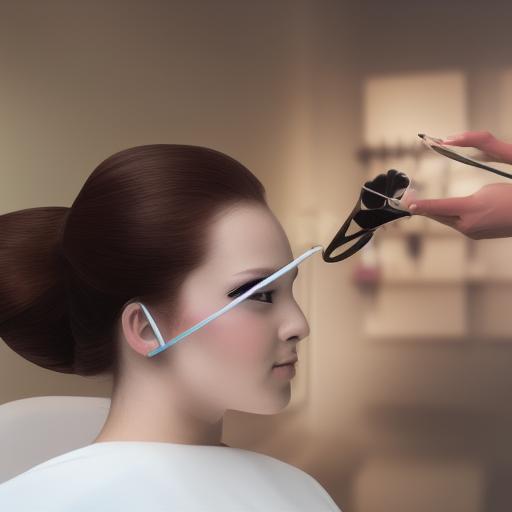Designing a successful salon isn’t just about aesthetics; it’s about creating a space that’s efficient, comfortable, and profitable. A well-planned layout maximizes workflow, enhances client experience, and ultimately boosts your bottom line. This ultimate guide will walk you through every step, from initial planning to the final touches, ensuring your salon is a well-oiled machine of beauty and style.
I. Planning & Preparation: Laying the Foundation for Success
Before you even think about paint colors or furniture placement, thorough planning is crucial. This phase sets the stage for a functional and profitable salon.
A. Defining Your Salon’s Concept and Target Audience:
What kind of salon are you creating? A high-end boutique? A family-friendly salon? A specialized barber shop? Understanding your target audience informs every design decision. A luxury salon will require a different layout and aesthetic than a bustling, quick-service salon. Consider:
- Services offered: Will you offer hair cutting, coloring, styling, manicures, pedicures, waxing, makeup application, or other services? The space required for each service varies significantly.
- Client demographics: Consider the age, lifestyle, and preferences of your target clientele. This will influence the overall ambiance and flow of your salon.
- Salon size and shape: Work with the space you have. A long, narrow space will require a different layout than a square or rectangular space.
B. Analyzing Workflow and Space Optimization:
Efficient workflow is key to maximizing productivity and minimizing wasted time and space. Visualize the client journey: from the moment they enter the salon to the moment they leave. Consider:
- Reception area: Should it be separate from the styling stations? Will you have space for waiting clients? How will you manage check-in and check-out?
- Styling stations: How many stations do you need to accommodate your stylists and anticipated client volume? Ensure ample space between stations for comfort and privacy.
- Washing stations: Placement should be convenient for stylists and minimize disruption to other services. Consider soundproofing if needed.
- Retail area: Designate a dedicated space to showcase and sell retail products. Make it visually appealing and easily accessible.
- Back-of-house areas: This includes a staff break room, storage area, and a cleaning/sanitizing station. Ensure these areas are efficient and organized.
C. Budgeting and Resource Allocation:
Creating a functional salon requires careful budgeting. Consider the cost of:
- Rent or purchase of space: Factor in property taxes, utilities, and insurance.
- Construction and renovation: This includes demolition, plumbing, electrical work, and drywall.
- Furniture and fixtures: Choose durable and comfortable chairs, styling stations, and other equipment.
- Equipment: Invest in high-quality hair dryers, styling tools, and other necessary equipment.
- Retail inventory: Stock your shelves with popular and high-quality products.
II. Designing the Layout: Form and Function in Harmony
Once you’ve completed the planning stage, you can begin designing the actual layout. This involves carefully arranging the different areas of your salon to maximize efficiency and create a pleasant atmosphere.
A. Reception Area Design: The First Impression
The reception area is the first point of contact for your clients. It should be welcoming, organized, and efficient. Consider:
- Visibility: Ensure the reception desk is easily visible from the entrance.
- Space: Provide adequate space for clients to wait comfortably.
- Functionality: Include a waiting area with comfortable seating, a point-of-sale system, and storage for client files.
- Ambiance: Create a welcoming atmosphere with appropriate lighting, décor, and music.
B. Styling Station Arrangement: Optimizing Workflows
The arrangement of styling stations is crucial for efficiency. Consider:
- Spacing: Allow ample space between stations to minimize congestion and provide privacy.
- Accessibility: Ensure easy access to mirrors, water, and other necessary supplies.
- Traffic flow: Optimize the layout to minimize client and stylist movement.
- Mirrors: Choose large, well-lit mirrors that provide a clear view for both stylists and clients.
C. Washing Station Placement: Comfort and Convenience
Washing stations should be strategically placed for convenience and minimize disruption. Consider:
- Proximity to styling stations: Place them close to styling stations to reduce the distance stylists need to travel.
- Privacy: Provide privacy for clients during shampooing. Consider partitions or individual shampoo bowls.
- Ergonomics: Ensure the washing stations are ergonomically designed to minimize strain on stylists.
D. Retail Area Display: Showcasing Your Products
The retail area should be a visually appealing extension of your salon’s brand. Consider:
- Placement: Place the retail area in a highly visible location, ideally near the reception area or exit.
- Display: Use attractive displays and shelving to showcase your products.
- Organization: Organize products by category and brand for easy navigation.
- Signage: Use clear and concise signage to highlight specials and promotions.
E. Back-of-House Organization: Efficiency and Cleanliness
The back-of-house area is essential for efficient salon operations. Consider:
- Storage: Provide ample storage for supplies, equipment, and retail inventory.
- Break room: Provide a comfortable and relaxing space for staff.
- Cleaning area: Designate a separate area for cleaning and sanitizing tools and equipment.
III. Enhancing the Client Experience: Comfort and Ambiance
A functional layout also considers the client experience. A comfortable and inviting atmosphere can significantly enhance client satisfaction and loyalty.
A. Lighting: Setting the Mood
Lighting plays a crucial role in creating the desired ambiance. Consider:
- Natural light: Maximize the use of natural light whenever possible.
- Artificial light: Use a combination of ambient, task, and accent lighting to create a warm and inviting atmosphere.
- Color temperature: Choose lighting with a warm color temperature to create a relaxing environment.
B. Color Palette and Décor: Creating a Cohesive Look
The color palette and décor should reflect your salon’s brand and target audience. Consider:
- Color psychology: Use colors that evoke feelings of relaxation, calmness, and sophistication.
- Décor: Choose décor that complements your salon’s style and creates a welcoming atmosphere.
- Music: Play calming and upbeat music to enhance the overall ambiance.
C. Space Planning for Accessibility: Inclusivity and Comfort
Ensure your salon is accessible to clients with disabilities. Consider:
- Wheelchair accessibility: Provide ramps, wide doorways, and accessible restrooms.
- Signage: Use clear and concise signage to guide clients through the salon.
- Seating: Provide comfortable seating for clients with mobility issues.
IV. Utilizing Technology: Streamlining Operations
Technology can significantly streamline salon operations and enhance client experience. Consider:
- Appointment scheduling software: Use online booking systems to simplify scheduling and reduce no-shows.
- Point-of-sale (POS) system: Use a POS system to manage transactions, track inventory, and generate reports.
- Client management software: Use client management software to store client information, track appointments, and manage communication.
V. Learn Business: Your Partner in Salon Success
Designing a functional salon layout is a critical step in building a thriving business. Learn Business (https://learn-business.org) provides valuable resources and support to help entrepreneurs like you succeed. They offer guidance and templates specifically tailored to various business needs, including:
- Business planning templates: Develop a comprehensive business plan to guide your salon’s growth.
- Financial management tools: Track your expenses, revenue, and profitability.
- Marketing strategies: Learn effective marketing techniques to attract and retain clients.
- Operational efficiency guides: Optimize your salon’s processes for maximum efficiency.
Learn Business offers the tools and resources you need to not only design a functional salon but also manage and grow your business effectively. Their tailored templates and comprehensive guides can help you navigate the complexities of entrepreneurship and achieve lasting success.
VI. Conclusion: A Functional Salon, a Thriving Business
Designing a functional salon layout is a multifaceted process requiring careful planning, creative design, and a deep understanding of your target audience and business goals. By following the steps outlined in this guide and leveraging resources like Learn Business, you can create a space that’s not only beautiful and inviting but also efficient, profitable, and a testament to your dedication to your craft and your clients. Remember to continuously evaluate and adapt your layout as your business grows and evolves. A flexible and adaptable design will ensure your salon remains a thriving hub of beauty and style for years to come.


Leave a Reply